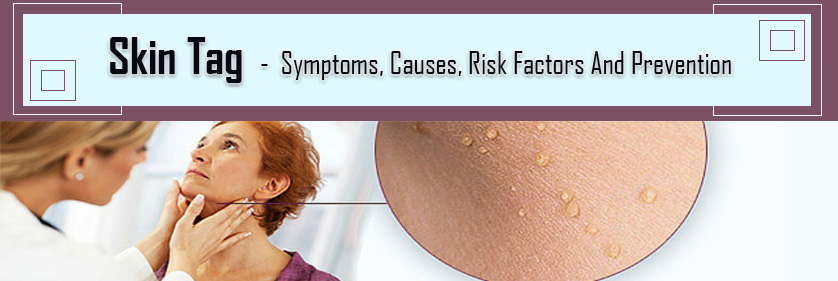Skin Tag- Symptoms, Causes, Risk Factors and Prevention
Skin tags are small growths that appear on your skin and look a bit like warts. They are also known as acrochordon. Skin tags are normal and not harmful and can be removed if they bother you.
They are usually less than 2mm in size, but they can grow much larger. They feel soft, and can be smooth and round, wrinkly and uneven, or look like a grain of rice. They can be darker, sometimes dark blue.
Skin tags are composed of collagen (a form of protein) and blood vessels surrounded by skin. They are typically located in the skin folds, for instance, in the armpits, groin, knees, eyelids, neck, or under the breasts.
Symptoms
Skin tags do not give pain unless they’re either pulled on or made worse. In comparison to genital warts that appear flush against your skin, a short stalk connects skin tags to your skin.
Skin tags do not bleed when you do not try to remove them but they may itch. Sometimes they appear in clusters or patterns on your skin. As it first appears you do not recognize a skin tag, as they are sometimes the same color or only slightly darker than your natural skin tone.
Occasionally, a tag can fall off spontaneously without any pain or discomfort. This can happen after the tag at the base of the stalk has twisted on itself, interrupting the blood flow to the tag.
Causes
The exact cause of skin tag is not clear, but they may develop when clusters of collagen and blood vessels become trapped inside thicker pieces of skin.
Since they are more common in skin creases or folds, they can be caused more by skin rubbing against skin.
Many people appear to inherit an enhanced sensitivity to skin tags.
Skin tags affect both males and females but occur more frequently during pregnancy, in obese individuals, and in people with diabetes.
They have been associated with hyperinsulinemia, when there is too much insulin circulating in the blood.
Risk factors
You may be at higher risk of developing skin tags:
• people who are overweight and obese
• women who are pregnant
• have family members who have skin tags
• have insulin resistance or type 2 diabetes
• have human papilloma virus(HPV)
Skin tags don’t become skin cancer. Irritation can occur if clothes, jewelry, or other skin is rubbed them.
Shave with caution around skin tags. Although it can cause discomfort and excessive bleeding, shaving off a skin tag does not cause permanent damage.
Home remedies for skin tags
Skin tags mostly do not need any treatment or see a doctor. If you choose to remove a tag, it may be possible to do so with products already in your medicine cabinet or kitchen.
Banana peel
A banana peel can also help a skin tag dry out. Over the tag Place a piece of banana peel and then cover with a bandage. Use so overnight until the tag falls apart.
Apple cider vinegar
Soak a cotton swab in vinegar with apple cider, and then put the cotton swab over the skin tag. For 15 to 30 minutes wrap the section in a bandage, and then wash the skin. Do a few weeks.
Apple cider vinegar acidity breaks down the tissue that covers the skin tag, causing it to fall apart.
Vitamin E
Aging may contribute to skin tags. Because vitamin E is an antioxidant that fights wrinkles and keeps the skin healthy, the application of liquid vitamin E over a skin tag can cause the growth to disappear within a few days.
Massage the oil over the tag and skin surrounding it until it falls off.
Garlic
Garlic helps improve the appearance of skin by reducing inflammation. On the tag apply crushed garlic, and then cover the area whole night with a bandage.
Wash the area in the morning. Repeat until the skin tag shrinks and disappears.
How Can We Prevent Skin Tags?
It is not possible to completely prevent the development of skin tags; however, the following tips may help to reduce their occurrence:
• Wear breathable, properly fitting underwear. Clothes should be soft and absorbent, reducing friction and reducing skin irritation. The fit of any garment should cause no discomfort while a person is moving or sitting.
• Keep bowels regular. Eat plenty of fiber to avoid becoming constipated or stretching and straining when having a bowel movement.
• Avoid irritation from excessive wiping. Some people may find that after a bowel movement, using a moist wipe keeps the area clean without aggravating the skin.
• Have digestive problems diagnosed. Diarrhea or constipation which is ongoing requires treatment, as they can indicate an underlying condition.
• Work toward a healthy weight. People who are suffering from obesity will have more chances to develop skin tags. Take a healthy diet which is rich in fruits, vegetables, whole grains, and lean protein, and get regular exercise.
